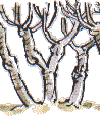 |
Witches' Broom7th January 2001, West Yorkshire |
![]()
![]()
![]()
![]()
![]()
![]() This Month
Rocks
History
Workshop
Links
Home Page
This Month
Rocks
History
Workshop
Links
Home Page
![]()
 AT THE top end of the woods, fresh leaves of Honeysuckle are beginning to unfurl.
AT THE top end of the woods, fresh leaves of Honeysuckle are beginning to unfurl.By a junction in the paths, several Silver Birches carry twiggy clumps of Witches Broom
 on their branches. There are two or three clumps on each of the infected trees. Witches' Broom galls can be caused by a mite, but these are probably the result of a fungus, Exoascus betulinus.
on their branches. There are two or three clumps on each of the infected trees. Witches' Broom galls can be caused by a mite, but these are probably the result of a fungus, Exoascus betulinus.Spring Line
We usually visit this part of the wood in spring or summer, when foliage softens the topography. It's surprising to see the same place in winter, when features such as a small steep hillock in the middle of the wood suddenly become obvious through the bare branches. Steep features like this in our coal measures landscape are usually topped by a bed of sandstone. Twenty yards to our left, down the slope, there is evidently an impervious layer of clay or shale. A line of springs produces a series of small pools and boggy patches.
Steep features like this in our coal measures landscape are usually topped by a bed of sandstone. Twenty yards to our left, down the slope, there is evidently an impervious layer of clay or shale. A line of springs produces a series of small pools and boggy patches.Birches favour the drier stony ground at the top of the slope, Crack Willows grow in the wetter valley bottom, alongside the stream.
Dating Hedges
 Working in the east Midlands, Dr Max Hooper devised a system for dating hedges, by surveying hedges for which a date was known. He discovered that on
Working in the east Midlands, Dr Max Hooper devised a system for dating hedges, by surveying hedges for which a date was known. He discovered that on  average one tree or shrub species colonised a hedge every one hundred years. Here's how it works;
average one tree or shrub species colonised a hedge every one hundred years. Here's how it works;Count the number of different tree and shrub species in a 30 metre stretch of hedge. If two species are found growing there the hedge will be around 200 years old. Dr Hooper found that he had to add 30 years onto this
 rough date to allow for the time that it took the hedge to become established. Bramble shouldn't be counted, nor should Elder, which can appear quite quickly in a hedge only to die out again later.
rough date to allow for the time that it took the hedge to become established. Bramble shouldn't be counted, nor should Elder, which can appear quite quickly in a hedge only to die out again later.In the short stretch of hedgerow at the entrance to the woods we find;
| Holly | Ash | Hawthorn | Blackthorn |
| Dog Rose | Elder | Sessile Oak | Hazel |
This could imply that this hedge might date back more than five hundred years. The hedge borders an old trackway; narrow lanes like this were the main routes through the area until turnpike roads were constructed in the 18th and early 19th century. But there could be another explanation for the variety of species; it was planted out near a wood, so an unusually wide variety of shrubs might have been used, simply because they were easily available.
![]()
Richard Bell,
wildlife illustrator
E-mail; 'richard@willowisland.co.uk'
![]() Next page
Previous page
This day last year
This month
Nature Diary
Home Page
Next page
Previous page
This day last year
This month
Nature Diary
Home Page
![]()